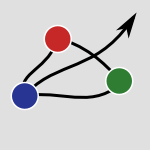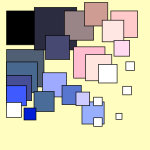257 papers:
 ECIR-2015-KotovRAR #microblog #modelling #retrieval
ECIR-2015-KotovRAR #microblog #modelling #retrieval- Geographical Latent Variable Models for Microblog Retrieval (AK, VR, EA, CKR), pp. 635–647.
 ECIR-2015-LiC #effectiveness #using
ECIR-2015-LiC #effectiveness #using- Effective Healthcare Advertising Using Latent Dirichlet Allocation and Inference Engine (YCL, CCC), pp. 672–677.
 ECIR-2015-VuWTS #personalisation #topic
ECIR-2015-VuWTS #personalisation #topic- Temporal Latent Topic User Profiles for Search Personalisation (TTV, AW, SNT, DS), pp. 605–616.
 ICML-2015-BachHBG #learning #performance
ICML-2015-BachHBG #learning #performance- Paired-Dual Learning for Fast Training of Latent Variable Hinge-Loss MRFs (SHB, BH, JLBG, LG), pp. 381–390.
 ICML-2015-FouldsKG #framework #modelling #network #probability #programming #topic
ICML-2015-FouldsKG #framework #modelling #network #probability #programming #topic- Latent Topic Networks: A Versatile Probabilistic Programming Framework for Topic Models (JRF, SHK, LG), pp. 777–786.
 ICML-2015-GalCG #category theory #estimation #multi #process
ICML-2015-GalCG #category theory #estimation #multi #process- Latent Gaussian Processes for Distribution Estimation of Multivariate Categorical Data (YG, YC, ZG), pp. 645–654.
 ICML-2015-ScholkopfHWFJSP #fault
ICML-2015-ScholkopfHWFJSP #fault- Removing systematic errors for exoplanet search via latent causes (BS, DWH, DW, DFM, DJ, CJSG, JP), pp. 2218–2226.
 KDD-2015-FuLPXGZZ #modelling #ranking
KDD-2015-FuLPXGZZ #modelling #ranking- Real Estate Ranking via Mixed Land-use Latent Models (YF, GL, SP, HX, YG, HZ, CZ), pp. 299–308.
 KDD-2015-MomtazpourZRSR #cyber-physical #invariant #using
KDD-2015-MomtazpourZRSR #cyber-physical #invariant #using- Analyzing Invariants in Cyber-Physical Systems using Latent Factor Regression (MM, JZ, SR, RKS, NR), pp. 2009–2018.
 KDD-2015-OuCWW0 #component #similarity #transitive
KDD-2015-OuCWW0 #component #similarity #transitive- Non-transitive Hashing with Latent Similarity Components (MO, PC, FW, JW, WZ), pp. 895–904.
 KDD-2015-SatoN #online #probability
KDD-2015-SatoN #online #probability- Stochastic Divergence Minimization for Online Collapsed Variational Bayes Zero Inference of Latent Dirichlet Allocation (IS, HN), pp. 1035–1044.
 KDD-2015-SongMT #network #performance #recommendation
KDD-2015-SongMT #network #performance #recommendation- Efficient Latent Link Recommendation in Signed Networks (DS, DAM, DT), pp. 1105–1114.
 KDD-2015-YangH #learning #multi
KDD-2015-YangH #learning #multi- Model Multiple Heterogeneity via Hierarchical Multi-Latent Space Learning (PY, JH), pp. 1375–1384.
 RecSys-2015-Guardia-Sebaoun #modelling #performance #recommendation
RecSys-2015-Guardia-Sebaoun #modelling #performance #recommendation- Latent Trajectory Modeling: A Light and Efficient Way to Introduce Time in Recommender Systems (ÉGS, VG, PG), pp. 281–284.
 RecSys-2015-Unger #recommendation
RecSys-2015-Unger #recommendation- Latent Context-Aware Recommender Systems (MU), pp. 383–386.
 SIGIR-2015-LiuW #collaboration #learning
SIGIR-2015-LiuW #collaboration #learning- Learning Context-aware Latent Representations for Context-aware Collaborative Filtering (XL, WW), pp. 887–890.
 SIGIR-2015-VolkovsY #effectiveness #feedback #modelling #recommendation
SIGIR-2015-VolkovsY #effectiveness #feedback #modelling #recommendation- Effective Latent Models for Binary Feedback in Recommender Systems (MV, GWY), pp. 313–322.
 SIGMOD-2014-HanW #mining
SIGMOD-2014-HanW #mining- Mining latent entity structures from massive unstructured and interconnected data (JH, CW), pp. 1409–1410.
 CIKM-2014-ShenHGDM #information retrieval #semantics
CIKM-2014-ShenHGDM #information retrieval #semantics- A Latent Semantic Model with Convolutional-Pooling Structure for Information Retrieval (YS, XH, JG, LD, GM), pp. 101–110.
 CIKM-2014-TakayamaTIOFC #detection #probability
CIKM-2014-TakayamaTIOFC #detection #probability- A Word-Scale Probabilistic Latent Variable Model for Detecting Human Values (YT, YT, EI, DWO, KRF, ASC), pp. 1489–1498.
 CIKM-2014-WenR #behaviour #identification #mining #online
CIKM-2014-WenR #behaviour #identification #mining #online- Identifying Latent Study Habits by Mining Learner Behavior Patterns in Massive Open Online Courses (MW, CPR), pp. 1983–1986.
 CIKM-2014-XuLLZCS #mining
CIKM-2014-XuLLZCS #mining- Latent Aspect Mining via Exploring Sparsity and Intrinsic Information (YX, TL, WL, ZZ, HC, AMCS), pp. 879–888.
 CIKM-2014-ZhangLCZW #collaboration
CIKM-2014-ZhangLCZW #collaboration- Exploit Latent Dirichlet Allocation for One-Class Collaborative Filtering (HZ, ZL, YC, XZ, SW), pp. 1991–1994.
 ECIR-2014-ZhangZWS #network #recommendation
ECIR-2014-ZhangZWS #network #recommendation- Content + Attributes: A Latent Factor Model for Recommending Scientific Papers in Heterogeneous Academic Networks (CZ, XZ, KW, JS), pp. 39–50.
 ICML-c1-2014-LethamSS #transaction
ICML-c1-2014-LethamSS #transaction- Latent Variable Copula Inference for Bundle Pricing from Retail Transaction Data (BL, WS, AS), pp. 217–225.
 ICML-c1-2014-LianREC #correlation #markov #modelling #process
ICML-c1-2014-LianREC #correlation #markov #modelling #process- Modeling Correlated Arrival Events with Latent Semi-Markov Processes (WL, VR, BE, LC), pp. 396–404.
 ICML-c1-2014-MaillardM
ICML-c1-2014-MaillardM- Latent Bandits (OAM, SM), pp. 136–144.
 ICML-c1-2014-SamdaniCR #clustering #online
ICML-c1-2014-SamdaniCR #clustering #online- A Discriminative Latent Variable Model for Online Clustering (RS, KWC, DR), pp. 1–9.
 ICML-c2-2014-ChagantyL #modelling #using #visual notation
ICML-c2-2014-ChagantyL #modelling #using #visual notation- Estimating Latent-Variable Graphical Models using Moments and Likelihoods (ATC, PL), pp. 1872–1880.
 ICML-c2-2014-LiG #classification #learning #representation #semantics
ICML-c2-2014-LiG #classification #learning #representation #semantics- Latent Semantic Representation Learning for Scene Classification (XL, YG), pp. 532–540.
 ICML-c2-2014-LindermanA #network #process
ICML-c2-2014-LindermanA #network #process- Discovering Latent Network Structure in Point Process Data (SWL, RPA), pp. 1413–1421.
 ICML-c2-2014-MengEH #learning #modelling #visual notation
ICML-c2-2014-MengEH #learning #modelling #visual notation- Learning Latent Variable Gaussian Graphical Models (ZM, BE, AOHI), pp. 1269–1277.
 ICML-c2-2014-SatoKN #analysis #normalisation
ICML-c2-2014-SatoKN #analysis #normalisation- Latent Confusion Analysis by Normalized Gamma Construction (IS, HK, HN), pp. 1116–1124.
 ICML-c2-2014-SongADX #estimation #modelling #multi #parametricity
ICML-c2-2014-SongADX #estimation #modelling #multi #parametricity- Nonparametric Estimation of Multi-View Latent Variable Models (LS, AA, BD, BX), pp. 640–648.
 ICPR-2014-AfkhamEC #framework #modelling
ICPR-2014-AfkhamEC #framework #modelling- A Topological Framework for Training Latent Variable Models (HMA, CHE, SC), pp. 2471–2476.
 ICPR-2014-ChenL #effectiveness #locality
ICPR-2014-ChenL #effectiveness #locality- Effective Part Localization in Latent-SVM Training (YC, RL), pp. 4269–4274.
 ICPR-2014-HaoXPSK #automation #semantics #topic #using
ICPR-2014-HaoXPSK #automation #semantics #topic #using- Automated Chinese Essay Scoring from Topic Perspective Using Regularized Latent Semantic Indexing (SH, YX, HP, KS, DK), pp. 3092–3097.
 ICPR-2014-KrishFROB #identification
ICPR-2014-KrishFROB #identification- Pre-registration for Improved Latent Fingerprint Identification (RPK, JF, DRC, JOG, JB), pp. 696–701.
 ICPR-2014-QianZX #classification #multi #social
ICPR-2014-QianZX #classification #multi #social- Boosted Multi-modal Supervised Latent Dirichlet Allocation for Social Event Classification (SQ, TZ, CX), pp. 1999–2004.
 ICPR-2014-WangGJ #learning #using
ICPR-2014-WangGJ #learning #using- Learning with Hidden Information Using a Max-Margin Latent Variable Model (ZW, TG, QJ), pp. 1389–1394.
 ICPR-2014-YangYHD #modelling #recognition
ICPR-2014-YangYHD #modelling #recognition- A Hierarchical Model Based on Latent Dirichlet Allocation for Action Recognition (SY, CY, WH, XD), pp. 2613–2618.
 KDD-2014-HuHA #e-commerce #modelling #scalability #social
KDD-2014-HuHA #e-commerce #modelling #scalability #social- Style in the long tail: discovering unique interests with latent variable models in large scale social E-commerce (DJH, RH, JA), pp. 1640–1649.
 KDD-2014-KurashimaITS #network #probability #visualisation
KDD-2014-KurashimaITS #network #probability #visualisation- Probabilistic latent network visualization: inferring and embedding diffusion networks (TK, TI, NT, HS), pp. 1236–1245.
 KDD-2014-RossCCD #clustering #process
KDD-2014-RossCCD #clustering #process- Dual beta process priors for latent cluster discovery in chronic obstructive pulmonary disease (JCR, PJC, MHC, JGD), pp. 155–162.
 SIGIR-2014-CarterCP #community #enterprise #modelling #query
SIGIR-2014-CarterCP #community #enterprise #modelling #query- Latent community discovery through enterprise user search query modeling (KMC, RSC, BP), pp. 871–874.
 SIGIR-2014-ChengYWL #behaviour #multi #recommendation
SIGIR-2014-ChengYWL #behaviour #multi #recommendation- Group latent factor model for recommendation with multiple user behaviors (JC, TY, JW, HL), pp. 995–998.
 SIGIR-2014-Sebastian #clustering #predict #semantics #using
SIGIR-2014-Sebastian #clustering #predict #semantics #using- Cluster links prediction for literature based discovery using latent structure and semantic features (YS), p. 1275.
 SIGIR-2014-TsolmonL #analysis #modelling #timeline
SIGIR-2014-TsolmonL #analysis #modelling #timeline- An event extraction model based on timeline and user analysis in Latent Dirichlet allocation (BT, KSL), pp. 1187–1190.
 SIGIR-2014-ZhangZLG #modelling
SIGIR-2014-ZhangZLG #modelling- Supervised hashing with latent factor models (PZ, WZ, WJL, MG), pp. 173–182.
 SIGIR-2014-ZhouDG #semantics #similarity
SIGIR-2014-ZhouDG #semantics #similarity- Latent semantic sparse hashing for cross-modal similarity search (JZ, GD, YG), pp. 415–424.
 SAC-2014-ChenZTWS #modelling #recommendation
SAC-2014-ChenZTWS #modelling #recommendation- Comparing the staples in latent factor models for recommender systems (CC, LZ, AT, KW, SV), pp. 91–96.
 SAC-2014-Zheng #matrix #using
SAC-2014-Zheng #matrix #using- Semi-supervised context-aware matrix factorization: using contexts in a way of “latent” factors (YZ), pp. 292–293.
 HT-2013-KrestelS #generative #sentiment #topic
HT-2013-KrestelS #generative #sentiment #topic- Generating contextualized sentiment lexica based on latent topics and user ratings (RK, SS), pp. 129–138.
 ICSM-2013-VenkataramaniABM #analysis #repository #scalability #semantics
ICSM-2013-VenkataramaniABM #analysis #repository #scalability #semantics- Latent Co-development Analysis Based Semantic Search for Large Code Repositories (RV, AMA, VDB, BM), pp. 372–375.
 CIKM-2013-ChanLKLBR #graph #matrix #using
CIKM-2013-ChanLKLBR #graph #matrix #using- Discovering latent blockmodels in sparse and noisy graphs using non-negative matrix factorisation (JC, WL, AK, CL, JB, KR), pp. 811–816.
 CIKM-2013-FangHZ #analysis #bibliography #sentiment
CIKM-2013-FangHZ #analysis #bibliography #sentiment- Exploring weakly supervised latent sentiment explanations for aspect-level review analysis (LF, MH, XZ), pp. 1057–1066.
 CIKM-2013-SordoniHN #information retrieval #interactive #modelling #quantum #topic #using
CIKM-2013-SordoniHN #information retrieval #interactive #modelling #quantum #topic #using- Modeling latent topic interactions using quantum interference for information retrieval (AS, JH, JYN), pp. 1197–1200.
 CIKM-2013-ZhiltsovA #linked data #modelling #open data #semantics
CIKM-2013-ZhiltsovA #linked data #modelling #open data #semantics- Improving entity search over linked data by modeling latent semantics (NZ, EA), pp. 1253–1256.
 ECIR-2013-GaoDGG #modelling #relational
ECIR-2013-GaoDGG #modelling #relational- Latent Factor BlockModel for Modelling Relational Data (SG, LD, PG, JG), pp. 447–458.
 ECIR-2013-PatilDV #concept
ECIR-2013-PatilDV #concept- Leveraging Latent Concepts for Retrieving Relevant Ads for Short Text (AP, KSD, VV), pp. 780–783.
 ICML-c1-2013-AnandkumarHJK #learning #linear #network
ICML-c1-2013-AnandkumarHJK #learning #linear #network- Learning Linear Bayesian Networks with Latent Variables (AA, DH, AJ, SK), pp. 249–257.
 ICML-c1-2013-HeaukulaniG #modelling #network #probability #social
ICML-c1-2013-HeaukulaniG #modelling #network #probability #social- Dynamic Probabilistic Models for Latent Feature Propagation in Social Networks (CH, ZG), pp. 275–283.
 ICML-c1-2013-ZhaiB #infinity #online
ICML-c1-2013-ZhaiB #infinity #online- Online Latent Dirichlet Allocation with Infinite Vocabulary (KZ, JLBG), pp. 561–569.
 ICML-c3-2013-AlmingolML #behaviour #learning #multi
ICML-c3-2013-AlmingolML #behaviour #learning #multi- Learning Multiple Behaviors from Unlabeled Demonstrations in a Latent Controller Space (JA, LM, ML), pp. 136–144.
 ICML-c3-2013-BryanM #interactive #performance
ICML-c3-2013-BryanM #interactive #performance- An Efficient Posterior Regularized Latent Variable Model for Interactive Sound Source Separation (NJB, GJM), pp. 208–216.
 ICML-c3-2013-IshtevaPS #order #using
ICML-c3-2013-IshtevaPS #order #using- Unfolding Latent Tree Structures using 4th Order Tensors (MI, HP, LS), pp. 316–324.
 ICML-c3-2013-KhanAFS #modelling #performance
ICML-c3-2013-KhanAFS #modelling #performance- Fast Dual Variational Inference for Non-Conjugate Latent Gaussian Models (MEK, AYA, MPF, MWS), pp. 951–959.
 ICML-c3-2013-SongIPXP #composition #modelling #visual notation
ICML-c3-2013-SongIPXP #composition #modelling #visual notation- Hierarchical Tensor Decomposition of Latent Tree Graphical Models (LS, MI, APP, EPX, HP), pp. 334–342.
 KDD-2013-BahadoriLX #learning #performance #probability #process
KDD-2013-BahadoriLX #learning #performance #probability #process- Fast structure learning in generalized stochastic processes with latent factors (MTB, YL, EPX), pp. 284–292.
 KDD-2013-FouldsBDSW #probability
KDD-2013-FouldsBDSW #probability- Stochastic collapsed variational Bayesian inference for latent Dirichlet allocation (JRF, LB, CD, PS, MW), pp. 446–454.
 KDD-2013-IwataSG #online #process #social
KDD-2013-IwataSG #online #process #social- Discovering latent influence in online social activities via shared cascade poisson processes (TI, AS, ZG), pp. 266–274.
 KDD-2013-ZhangWF #recommendation
KDD-2013-ZhangWF #recommendation- Combining latent factor model with location features for event-based group recommendation (WZ, JW, WF), pp. 910–918.
 RecSys-2013-KrestelS #recommendation #topic
RecSys-2013-KrestelS #recommendation #topic- Recommending patents based on latent topics (RK, PS), pp. 395–398.
 RecSys-2013-WestonWY #multi
RecSys-2013-WestonWY #multi- Nonlinear latent factorization by embedding multiple user interests (JW, RJW, HY), pp. 65–68.
 RecSys-2013-ZhengI #effectiveness
RecSys-2013-ZhengI #effectiveness- Effectiveness of the data generated on different time in latent factor model (QZ, HHSI), pp. 327–330.
 SEKE-2013-Al-MsiedeenSHUVS #concept analysis #mining #object-oriented #semantics #source code #using
SEKE-2013-Al-MsiedeenSHUVS #concept analysis #mining #object-oriented #semantics #source code #using- Mining Features from the Object-Oriented Source Code of a Collection of Software Variants Using Formal Concept Analysis and Latent Semantic Indexing (RAM, ADS, MH, CU, SV, HES), pp. 244–249.
 SIGIR-2013-AnH #analysis #information retrieval #probability #semantics
SIGIR-2013-AnH #analysis #information retrieval #probability #semantics- Boosting novelty for biomedical information retrieval through probabilistic latent semantic analysis (XA, JXH), pp. 829–832.
 SIGIR-2013-LinSKC #modelling #recommendation #twitter
SIGIR-2013-LinSKC #modelling #recommendation #twitter- Addressing cold-start in app recommendation: latent user models constructed from twitter followers (JL, KS, MYK, TSC), pp. 283–292.
 SIGIR-2013-ZhangWYW #learning #network #predict
SIGIR-2013-ZhangWYW #learning #network #predict- Learning latent friendship propagation networks with interest awareness for link prediction (JZ, CW, PSY, JW), pp. 63–72.
 VLDB-2012-TauheedHSMA #named #query
VLDB-2012-TauheedHSMA #named #query- SCOUT: Prefetching for Latent Feature Following Queries (FT, TH, FS, HM, AA), pp. 1531–1542.
 CSMR-2012-IslamMSS #multi #semantics #testing
CSMR-2012-IslamMSS #multi #semantics #testing- A Multi-Objective Technique to Prioritize Test Cases Based on Latent Semantic Indexing (MMI, AM, AS, GS), pp. 21–30.
 ICSM-2012-IslamMSKS #algorithm #named #search-based #semantics #sorting #testing
ICSM-2012-IslamMSKS #algorithm #named #search-based #semantics #sorting #testing- MOTCP: A tool for the prioritization of test cases based on a sorting genetic algorithm and Latent Semantic Indexing (MMI, AM, AS, FBK, GS), pp. 654–657.
 CSCW-2012-PaoMCR #approach #collaboration #design
CSCW-2012-PaoMCR #approach #collaboration #design- A need-driven design approach: addressing latent needs in collaboration rooted in early childhood (SYP, SM, KC, AR), pp. 829–832.
 CIKM-2012-BohmKN #topic
CIKM-2012-BohmKN #topic- Latent topics in graph-structured data (CB, GK, FN), pp. 2663–2666.
 CIKM-2012-FangS #approach #feedback #learning #recommendation
CIKM-2012-FangS #approach #feedback #learning #recommendation- A latent pairwise preference learning approach for recommendation from implicit feedback (YF, LS), pp. 2567–2570.
 CIKM-2012-LiuW #analysis #on the #semantics
CIKM-2012-LiuW #analysis #on the #semantics- On the connections between explicit semantic analysis and latent semantic analysis (CL, YMW), pp. 1804–1808.
 CIKM-2012-YaoS #learning #relational #ubiquitous
CIKM-2012-YaoS #learning #relational #ubiquitous- Exploiting latent relevance for relational learning of ubiquitous things (LY, QZS), pp. 1547–1551.
 ECIR-2012-QuattoniCT #ranking #retrieval
ECIR-2012-QuattoniCT #ranking #retrieval- A Latent Variable Ranking Model for Content-Based Retrieval (AQ, XC, AT), pp. 340–351.
 ICML-2012-HanLC #learning #modelling #multi
ICML-2012-HanLC #learning #modelling #multi- Cross-Domain Multitask Learning with Latent Probit Models (SH, XL, LC), p. 51.
 ICML-2012-HartikainenSS #modelling #predict
ICML-2012-HartikainenSS #modelling #predict- State-Space Inference for Non-Linear Latent Force Models with Application to Satellite Orbit Prediction (JH, MS, SS), p. 96.
 ICML-2012-JalaliS #dependence #graph #learning
ICML-2012-JalaliS #dependence #graph #learning- Learning the Dependence Graph of Time Series with Latent Factors (AJ, SS), p. 83.
 ICML-2012-JawanpuriaN #learning
ICML-2012-JawanpuriaN #learning- A Convex Feature Learning Formulation for Latent Task Structure Discovery (PJ, JSN), p. 199.
 ICML-2012-KimL #graph #multi
ICML-2012-KimL #graph #multi- Latent Multi-group Membership Graph Model (MK, JL), p. 124.
 ICML-2012-KumarPK #learning #modelling #nondeterminism
ICML-2012-KumarPK #learning #modelling #nondeterminism- Modeling Latent Variable Uncertainty for Loss-based Learning (MPK, BP, DK), p. 29.
 ICML-2012-LiuL #modelling #multi #named
ICML-2012-LiuL #modelling #multi #named- Sparse-GEV: Sparse Latent Space Model for Multivariate Extreme Value Time Serie Modeling (YL, MTB, HL), p. 156.
 ICML-2012-MimnoHB #probability
ICML-2012-MimnoHB #probability- Sparse stochastic inference for latent Dirichlet allocation (DMM, MDH, DMB), p. 197.
 ICML-2012-PallaKG #infinity #network
ICML-2012-PallaKG #infinity #network- An Infinite Latent Attribute Model for Network Data (KP, DAK, ZG), p. 55.
 ICML-2012-PassosRWD #flexibility #learning #modelling #multi
ICML-2012-PassosRWD #flexibility #learning #modelling #multi- Flexible Modeling of Latent Task Structures in Multitask Learning (AP, PR, JW, HDI), p. 167.
 ICML-2012-SalazarC #category theory #relational
ICML-2012-SalazarC #category theory #relational- Inferring Latent Structure From Mixed Real and Categorical Relational Data (ES, LC), p. 219.
 ICML-2012-SchwingHPU #modelling #performance #predict #visual notation
ICML-2012-SchwingHPU #modelling #performance #predict #visual notation- Efficient Structured Prediction with Latent Variables for General Graphical Models (AGS, TH, MP, RU), p. 216.
 ICML-2012-WestonWWB #collaboration #retrieval
ICML-2012-WestonWWB #collaboration #retrieval- Latent Collaborative Retrieval (JW, CW, RJW, AB), p. 61.
 ICML-2012-Zhu #feature model #modelling #parametricity #predict
ICML-2012-Zhu #feature model #modelling #parametricity #predict- Max-Margin Nonparametric Latent Feature Models for Link Prediction (JZ), p. 154.
 ICPR-2012-CaoL #categorisation #fuzzy
ICPR-2012-CaoL #categorisation #fuzzy- Type-2 fuzzy labeled latent Dirichlet allocation for human action categorization (XQC, ZQL), pp. 1338–1341.
 KDD-2012-MiaoGMYTAS #analysis #documentation
KDD-2012-MiaoGMYTAS #analysis #documentation- Latent association analysis of document pairs (GM, ZG, LEM, XY, ST, NA, JS), pp. 1415–1423.
 KDD-2012-ShenJ #learning #recommendation #social
KDD-2012-ShenJ #learning #recommendation #social- Learning personal + social latent factor model for social recommendation (YS, RJ), pp. 1303–1311.
 KDD-2012-WangAB #modelling #named #online #performance #social #social media #topic
KDD-2012-WangAB #modelling #named #online #performance #social #social media #topic- TM-LDA: efficient online modeling of latent topic transitions in social media (YW, EA, MB), pp. 123–131.
 KDIR-2012-HavaSK #classification #documentation #network #semantics
KDIR-2012-HavaSK #classification #documentation #network #semantics- Contextual Latent Semantic Networks used for Document Classification (OH, MS, PK), pp. 425–430.
 KDIR-2012-IkebeKT #learning #predict #smarttech #using
KDIR-2012-IkebeKT #learning #predict #smarttech #using- Friendship Prediction using Semi-supervised Learning of Latent Features in Smartphone Usage Data (YI, MK, HT), pp. 199–205.
 RecSys-2012-Manzato #recommendation
RecSys-2012-Manzato #recommendation- Discovering latent factors from movies genres for enhanced recommendation (MGM), pp. 249–252.
 SIGIR-2012-ChenLYYN #network #social #web
SIGIR-2012-ChenLYYN #network #social #web- Finding web appearances of social network users via latent factor model (KC, ZL, XY, YY, ZN), pp. 1077–1078.
 SIGIR-2012-ShiZWLH #adaptation #recommendation
SIGIR-2012-ShiZWLH #adaptation #recommendation- Adaptive diversification of recommendation results via latent factor portfolio (YS, XZ, JW, ML, AH), pp. 175–184.
 HT-2011-SeroussiBZ #modelling #personalisation #predict #rating #using
HT-2011-SeroussiBZ #modelling #personalisation #predict #rating #using- Personalised rating prediction for new users using latent factor models (YS, FB, IZ), pp. 47–56.
 SIGMOD-2011-AgarwalC
SIGMOD-2011-AgarwalC- Latent OLAP: data cubes over latent variables (DA, BCC), pp. 877–888.
 ITiCSE-2011-KleinKT #analysis #assessment #automation #semantics #using
ITiCSE-2011-KleinKT #analysis #assessment #automation #semantics #using- Automated assessment of short free-text responses in computer science using latent semantic analysis (RK, AK, MT), pp. 158–162.
 HCI-DDA-2011-KogaT #recommendation #topic #twitter #using
HCI-DDA-2011-KogaT #recommendation #topic #twitter #using- Developing a User Recommendation Engine on Twitter Using Estimated Latent Topics (HK, TT), pp. 461–470.
 CIKM-2011-Ando #encoding #relational #using
CIKM-2011-Ando #encoding #relational #using- Latent feature encoding using dyadic and relational data (SA), pp. 2201–2204.
 CIKM-2011-BespalovBQS #analysis #classification #n-gram #sentiment
CIKM-2011-BespalovBQS #analysis #classification #n-gram #sentiment- Sentiment classification based on supervised latent n-gram analysis (DB, BB, YQ, AS), pp. 375–382.
 CIKM-2011-BingLW #query #social #topic #using
CIKM-2011-BingLW #query #social #topic #using- Using query log and social tagging to refine queries based on latent topics (LB, WL, TLW), pp. 583–592.
 CIKM-2011-Bradford #implementation #scalability #semantics
CIKM-2011-Bradford #implementation #scalability #semantics- Implementation techniques for large-scale latent semantic indexing applications (RBB), pp. 339–344.
 CIKM-2011-GaoL #adaptation #analysis #classification #probability #sentiment #using
CIKM-2011-GaoL #adaptation #analysis #classification #probability #sentiment #using- A cross-domain adaptation method for sentiment classification using probabilistic latent analysis (SG, HL), pp. 1047–1052.
 CIKM-2011-GuoZGS #analysis #aspect-oriented #multi #sentiment
CIKM-2011-GuoZGS #analysis #aspect-oriented #multi #sentiment- Domain customization for aspect-oriented opinion analysis with multi-level latent sentiment clues (HG, HZ, ZG, ZS), pp. 2493–2496.
 CIKM-2011-HarveyCRC #collaboration #modelling #predict #rating
CIKM-2011-HarveyCRC #collaboration #modelling #predict #rating- Bayesian latent variable models for collaborative item rating prediction (MH, MJC, IR, FC), pp. 699–708.
 CIKM-2011-LiuCZH #learning #random
CIKM-2011-LiuCZH #learning #random- Learning conditional random fields with latent sparse features for acronym expansion finding (JL, JC, YZ, YH), pp. 867–872.
 CIKM-2011-QuC #probability
CIKM-2011-QuC #probability- Sparse structured probabilistic projections for factorized latent spaces (XQ, XC), pp. 1389–1394.
 CIKM-2011-RenMWL #process #thread #topic #web
CIKM-2011-RenMWL #process #thread #topic #web- Summarizing web forum threads based on a latent topic propagation process (ZR, JM, SW, YL), pp. 879–884.
 CIKM-2011-SannerGGKK #optimisation #retrieval #topic
CIKM-2011-SannerGGKK #optimisation #retrieval #topic- Diverse retrieval via greedy optimization of expected 1-call@k in a latent subtopic relevance model (SS, SG, TG, SK, SK), pp. 1977–1980.
 CIKM-2011-ShiLY #graph #predict
CIKM-2011-ShiLY #graph #predict- Collective prediction with latent graphs (XS, YL, PSY), pp. 1127–1136.
 CIKM-2011-WahabzadaKPB #performance #scheduling
CIKM-2011-WahabzadaKPB #performance #scheduling- More influence means less work: fast latent dirichlet allocation by influence scheduling (MW, KK, AP, CB), pp. 2273–2276.
 ECIR-2011-He #classification #sentiment
ECIR-2011-He #classification #sentiment- Latent Sentiment Model for Weakly-Supervised Cross-Lingual Sentiment Classification (YH), pp. 214–225.
 ECIR-2011-Rehurek #analysis #semantics
ECIR-2011-Rehurek #analysis #semantics- Subspace Tracking for Latent Semantic Analysis (RR), pp. 289–300.
 ECIR-2011-TackstromM #fine-grained #modelling #predict #sentiment
ECIR-2011-TackstromM #fine-grained #modelling #predict #sentiment- Discovering Fine-Grained Sentiment with Latent Variable Structured Prediction Models (OT, RTM), pp. 368–374.
 ICML-2011-MarlinKM #bound #modelling
ICML-2011-MarlinKM #bound #modelling- Piecewise Bounds for Estimating Bernoulli-Logistic Latent Gaussian Models (BMM, MEK, KPM), pp. 633–640.
 ICML-2011-ParikhSX #algorithm #modelling #visual notation
ICML-2011-ParikhSX #algorithm #modelling #visual notation- A Spectral Algorithm for Latent Tree Graphical Models (APP, LS, EPX), pp. 1065–1072.
 KDD-2011-AndrzejewskiB #feedback #information retrieval #topic
KDD-2011-AndrzejewskiB #feedback #information retrieval #topic- Latent topic feedback for information retrieval (DA, DB), pp. 600–608.
 KDD-2011-LiuHLMPV #modelling #predict #quality #visual notation
KDD-2011-LiuHLMPV #modelling #predict #quality #visual notation- Latent graphical models for quantifying and predicting patent quality (YL, PyH, RL, SM, CP, AV), pp. 1145–1153.
 KDD-2011-WangLZ #analysis #keyword #rating
KDD-2011-WangLZ #analysis #keyword #rating- Latent aspect rating analysis without aspect keyword supervision (HW, YL, CZ), pp. 618–626.
 SIGIR-2011-CetintasCSSD #modelling #online #probability
SIGIR-2011-CetintasCSSD #modelling #online #probability- Forecasting counts of user visits for online display advertising with probabilistic latent class models (SC, DC, LS, BS, ZD), pp. 1217–1218.
 SIGIR-2011-GaoTY #modelling #semantics #web
SIGIR-2011-GaoTY #modelling #semantics #web- Clickthrough-based latent semantic models for web search (JG, KT, WtY), pp. 675–684.
 SIGIR-2011-MoghaddamE #aspect-oriented #learning #named #online
SIGIR-2011-MoghaddamE #aspect-oriented #learning #named #online- ILDA: interdependent LDA model for learning latent aspects and their ratings from online product reviews (SM, ME), pp. 665–674.
 SIGIR-2011-WangA #analysis #semantics
SIGIR-2011-WangA #analysis #semantics- Temporal latent semantic analysis for collaboratively generated content: preliminary results (YW, EA), pp. 1145–1146.
 SIGIR-2011-WangXLC #semantics
SIGIR-2011-WangXLC #semantics- Regularized latent semantic indexing (QW, JX, HL, NC), pp. 685–694.
 MoDELS-2011-JensenCGN #behaviour #detection
MoDELS-2011-JensenCGN #behaviour #detection- A Toolchain for the Detection of Structural and Behavioral Latent System Properties (ACJ, BHCC, HG, ECN), pp. 683–698.
 MoDELS-2011-JensenCGN #behaviour #detection
MoDELS-2011-JensenCGN #behaviour #detection- A Toolchain for the Detection of Structural and Behavioral Latent System Properties (ACJ, BHCC, HG, ECN), pp. 683–698.
 ICSM-2010-SavageDGP #named #source code #topic #using
ICSM-2010-SavageDGP #named #source code #topic #using- TopicXP: Exploring topics in source code using Latent Dirichlet Allocation (TS, BD, MG, DP), pp. 1–6.
 SCAM-2010-GrantC #analysis #concept #source code
SCAM-2010-GrantC #analysis #concept #source code- Estimating the Optimal Number of Latent Concepts in Source Code Analysis (SG, JRC), pp. 65–74.
 SEFM-2010-ScannielloRT #architecture #empirical #evaluation #semantics #using
SEFM-2010-ScannielloRT #architecture #empirical #evaluation #semantics #using- Architecture Recovery Using Latent Semantic Indexing and K-Means: An Empirical Evaluation (GS, MR, GT), pp. 103–112.
 CIKM-2010-Kawamae #topic
CIKM-2010-Kawamae #topic- Latent interest-topic model: finding the causal relationships behind dyadic data (NK), pp. 649–658.
 CIKM-2010-LangMWL #concept #markov #random #using
CIKM-2010-LangMWL #concept #markov #random #using- Improved latent concept expansion using hierarchical markov random fields (HL, DM, BW, JTL), pp. 249–258.
 ECIR-2010-HuLW #collaboration
ECIR-2010-HuLW #collaboration- User’s Latent Interest-Based Collaborative Filtering (BH, ZL, JW), pp. 619–622.
 ICML-2010-FelzenszwalbGMR #detection #modelling
ICML-2010-FelzenszwalbGMR #detection #modelling- Discriminative Latent Variable Models for Object Detection (PFF, RBG, DAM, DR), pp. 11–12.
 ICPR-2010-CarliBBM #generative #kernel #modelling
ICPR-2010-CarliBBM #generative #kernel #modelling- Nonlinear Mappings for Generative Kernels on Latent Variable Models (ACC, MB, SB, VM), pp. 2134–2137.
 ICPR-2010-DeufemiaRT #recognition #sketching
ICPR-2010-DeufemiaRT #recognition #sketching- Sketched Symbol Recognition with a Latent-Dynamic Conditional Model (VD, MR, GT), pp. 1100–1103.
 ICPR-2010-ErgulA #classification #topic #using
ICPR-2010-ErgulA #classification #topic #using- Scene Classification Using Spatial Pyramid of Latent Topics (EE, NA), pp. 3603–3606.
 ICPR-2010-PuertasRFOE #comprehension #forensics #performance #recognition #towards
ICPR-2010-PuertasRFOE #comprehension #forensics #performance #recognition #towards- Towards a Better Understanding of the Performance of Latent Fingerprint Recognition in Realistic Forensic Conditions (MP, DR, JF, JOG, NE), pp. 1638–1641.
 ICPR-2010-SuS #predict #process
ICPR-2010-SuS #predict #process- Latent Fingerprint Core Point Prediction Based on Gaussian Processes (CS, SNS), pp. 1634–1637.
 KDD-2010-DuBoisS #modelling #relational
KDD-2010-DuBoisS #modelling #relational- Modeling relational events via latent classes (CD, PS), pp. 803–812.
 KDD-2010-WangLZ #analysis #approach #bibliography #rating
KDD-2010-WangLZ #analysis #approach #bibliography #rating- Latent aspect rating analysis on review text data: a rating regression approach (HW, YL, CZ), pp. 783–792.
 SIGIR-2010-GuoS #probability
SIGIR-2010-GuoS #probability- Probabilistic latent maximal marginal relevance (SG, SS), pp. 833–834.
 MoDELS-v1-2010-GoldsbyC #automation #behaviour #modelling #uml
MoDELS-v1-2010-GoldsbyC #automation #behaviour #modelling #uml- Automatically Discovering Properties That Specify the Latent Behavior of UML Models (HG, BHCC), pp. 316–330.
 SAC-2010-NetoGBPM #automation #documentation #fault #image #semantics
SAC-2010-NetoGBPM #automation #documentation #fault #image #semantics- An automatic linking service of document images reducing the effects of OCR errors with latent semantics (RBN, JACG, AB, JP, AAM), pp. 13–17.
 FSE-2010-KillianNPBAJ #debugging #implementation #performance
FSE-2010-KillianNPBAJ #debugging #implementation #performance- Finding latent performance bugs in systems implementations (CEK, KN, SP, RB, JWA, RJ), pp. 17–26.
 ICSM-2009-LiuPFGC #modelling #topic
ICSM-2009-LiuPFGC #modelling #topic- Modeling class cohesion as mixtures of latent topics (YL, DP, RF, TG, NC), pp. 233–242.
 MSR-2009-TianRP #automation #categorisation #using
MSR-2009-TianRP #automation #categorisation #using- Using Latent Dirichlet Allocation for automatic categorization of software (KT, MR, DP), pp. 163–166.
 HIMI-II-2009-SawaragiIHN #approach #identification #using
HIMI-II-2009-SawaragiIHN #approach #identification #using- Identifying Latent Similarities among Near-Miss Incident Records Using a Text-Mining Method and a Scenario-Based Approach (TS, KI, YH, HN), pp. 594–603.
 CIKM-2009-GuoZGZS #categorisation #multi #semantics
CIKM-2009-GuoZGZS #categorisation #multi #semantics- Product feature categorization with multilevel latent semantic association (HG, HZ, ZG, XZ, ZS), pp. 1087–1096.
 CIKM-2009-LiuZY #analysis #collaboration #probability
CIKM-2009-LiuZY #analysis #collaboration #probability- Probabilistic latent preference analysis for collaborative filtering (NNL, MZ, QY), pp. 759–766.
 CIKM-2009-ParkR #analysis #information retrieval #kernel #semantics #using
CIKM-2009-ParkR #analysis #information retrieval #kernel #semantics #using- Kernel latent semantic analysis using an information retrieval based kernel (LAFP, KR), pp. 1721–1724.
 CIKM-2009-WangTFCYL #ranking
CIKM-2009-WangTFCYL #ranking- Heterogeneous cross domain ranking in latent space (BW, JT, WF, SC, ZY, YL), pp. 987–996.
 CIKM-2009-YoonSKP #community
CIKM-2009-YoonSKP #community- Extraction of a latent blog community based on subject (SHY, JHS, SWK, SP), pp. 1529–1532.
 ECIR-2009-BolelliEG #detection #topic #using
ECIR-2009-BolelliEG #detection #topic #using- Topic and Trend Detection in Text Collections Using Latent Dirichlet Allocation (LB, SE, CLG), pp. 776–780.
 ICML-2009-YuJ #learning
ICML-2009-YuJ #learning- Learning structural SVMs with latent variables (CNJY, TJ), pp. 1169–1176.
 KDD-2009-AgarwalC #modelling
KDD-2009-AgarwalC #modelling- Regression-based latent factor models (DA, BCC), pp. 19–28.
 KDD-2009-GuoZGZS #semantics #standard
KDD-2009-GuoZGZS #semantics #standard- Address standardization with latent semantic association (HG, HZ, ZG, XZ, ZS), pp. 1155–1164.
 KDD-2009-TangL #learning #relational #social
KDD-2009-TangL #learning #relational #social- Relational learning via latent social dimensions (LT, HL), pp. 817–826.
 KDD-2009-WangCP #aspect-oriented #mining #query
KDD-2009-WangCP #aspect-oriented #mining #query- Mining broad latent query aspects from search sessions (XW, DC, KP), pp. 867–876.
 KDD-2009-XuYL #mining #using
KDD-2009-XuYL #mining #using- Named entity mining from click-through data using weakly supervised latent dirichlet allocation (GX, SHY, HL), pp. 1365–1374.
 RecSys-2009-KrestelFN #recommendation
RecSys-2009-KrestelFN #recommendation- Latent dirichlet allocation for tag recommendation (RK, PF, WN), pp. 61–68.
 SIGIR-2009-BrunoM #approach #clustering #modelling #multi #using
SIGIR-2009-BrunoM #approach #clustering #modelling #multi #using- Multiview clustering: a late fusion approach using latent models (EB, SMM), pp. 736–737.
 SIGIR-2009-GuoZCZG #documentation #topic
SIGIR-2009-GuoZCZG #documentation #topic- A latent topic model for linked documents (ZG, SZ, YC, ZZ, YG), pp. 720–721.
 SIGIR-2009-Peng #analysis #equivalence #probability #semantics
SIGIR-2009-Peng #analysis #equivalence #probability #semantics- Equivalence between nonnegative tensor factorization and tensorial probabilistic latent semantic analysis (WP), pp. 668–669.
 SAC-2009-HendersonE #graph #scalability
SAC-2009-HendersonE #graph #scalability- Applying latent dirichlet allocation to group discovery in large graphs (KH, TER), pp. 1456–1461.
 ASE-2008-JiangNCJC #automation #evolution #incremental #semantics #traceability
ASE-2008-JiangNCJC #automation #evolution #incremental #semantics #traceability- Incremental Latent Semantic Indexing for Automatic Traceability Link Evolution Management (HJ, TNN, IXC, HJ, CKC), pp. 59–68.
 CSMR-2008-SpekKL #architecture #concept #semantics #towards #using
CSMR-2008-SpekKL #architecture #concept #semantics #towards #using- Towards Recovering Architectural Concepts Using Latent Semantic Indexing (PvdS, SK, PvdL), pp. 253–257.
 WCRE-2008-LukinsKE #debugging #locality #retrieval #source code #using
WCRE-2008-LukinsKE #debugging #locality #retrieval #source code #using- Source Code Retrieval for Bug Localization Using Latent Dirichlet Allocation (SKL, NAK, LHE), pp. 155–164.
 CHI-2008-KatsanosTA #analysis #architecture #design #named #semantics #using #web
CHI-2008-KatsanosTA #analysis #architecture #design #named #semantics #using #web- AutoCardSorter: designing the information architecture of a web site using latent semantic analysis (CK, NKT, NMA), pp. 875–878.
 CHI-2008-MiaskiewiczSK #analysis #identification #semantics
CHI-2008-MiaskiewiczSK #analysis #identification #semantics- A latent semantic analysis methodology for the identification and creation of personas (TM, TS, KAK), pp. 1501–1510.
 CIKM-2008-Bradford #empirical #scalability #semantics
CIKM-2008-Bradford #empirical #scalability #semantics- An empirical study of required dimensionality for large-scale latent semantic indexing applications (RBB), pp. 153–162.
 CIKM-2008-HuangS #markov #query #using
CIKM-2008-HuangS #markov #query #using- A latent variable model for query expansion using the hidden markov model (QH, DS), pp. 1417–1418.
 CIKM-2008-MaYKL #learning #query #semantics
CIKM-2008-MaYKL #learning #query #semantics- Learning latent semantic relations from clickthrough data for query suggestion (HM, HY, IK, MRL), pp. 709–718.
 ICML-2008-UrtasunFGPDL #modelling
ICML-2008-UrtasunFGPDL #modelling- Topologically-constrained latent variable models (RU, DJF, AG, JP, TD, NDL), pp. 1080–1087.
 ICPR-2008-GaoCY #modelling #process
ICPR-2008-GaoCY #modelling #process- Manifold denoising with Gaussian Process Latent Variable Models (YG, KLC, WYY), pp. 1–4.
 KDD-2008-IwataYU #documentation #probability #semantics #topic #visualisation
KDD-2008-IwataYU #documentation #probability #semantics #topic #visualisation- Probabilistic latent semantic visualization: topic model for visualizing documents (TI, TY, NU), pp. 363–371.
 KDD-2008-NallapatiAXC #modelling #topic
KDD-2008-NallapatiAXC #modelling #topic- Joint latent topic models for text and citations (RN, AA, EPX, WWC), pp. 542–550.
 KDD-2008-PorteousNIASW #performance
KDD-2008-PorteousNIASW #performance- Fast collapsed gibbs sampling for latent dirichlet allocation (IP, DN, ATI, AUA, PS, MW), pp. 569–577.
 RecSys-2008-WuWC #analysis #automation #incremental #probability #recommendation #semantics
RecSys-2008-WuWC #analysis #automation #incremental #probability #recommendation #semantics- Incremental probabilistic latent semantic analysis for automatic question recommendation (HW, YW, XC), pp. 99–106.
 SIGIR-2008-QuanCLX #adaptation #scalability #semantics
SIGIR-2008-QuanCLX #adaptation #scalability #semantics- Adaptive label-driven scaling for latent semantic indexing (XQ, EC, QL, HX), pp. 827–828.
 OOPSLA-2008-BaldiLLB #aspect-oriented #formal method #topic
OOPSLA-2008-BaldiLLB #aspect-oriented #formal method #topic- A theory of aspects as latent topics (PB, CVL, EL, SKB), pp. 543–562.
 SAC-2008-Papadopoulos #analysis #retrieval #semantics
SAC-2008-Papadopoulos #analysis #retrieval #semantics- Trajectory retrieval with latent semantic analysis (ANP), pp. 1089–1094.
 FSE-2008-BirdPDFD #open source #social
FSE-2008-BirdPDFD #open source #social- Latent social structure in open source projects (CB, DSP, RMD, VF, PTD), pp. 24–35.
 ICSE-2008-LuciaOT #semantics #traceability
ICSE-2008-LuciaOT #semantics #traceability- Adams re-trace: traceability link recovery via latent semantic indexing (ADL, RO, GT), pp. 839–842.
 DAC-2007-SingheeR #performance #statistics
DAC-2007-SingheeR #performance #statistics- Beyond Low-Order Statistical Response Surfaces: Latent Variable Regression for Efficient, Highly Nonlinear Fitting (AS, RAR), pp. 256–261.
 ICDAR-2007-BanerjeeHC #concept #database #documentation #image #query #semantics #word
ICDAR-2007-BanerjeeHC #concept #database #documentation #image #query #semantics #word- Word image based latent semantic indexing for conceptual querying in document image databases (SB, GH, SC), pp. 1208–1212.
 CIKM-2007-PhamMLC #image #retrieval #semantics
CIKM-2007-PhamMLC #image #retrieval #semantics- Latent semantic fusion model for image retrieval and annotation (TTP, NM, JHL, JPC), pp. 439–444.
 ICML-2007-LawrenceM #modelling #process
ICML-2007-LawrenceM #modelling #process- Hierarchical Gaussian process latent variable models (NDL, AJM), pp. 481–488.
 ICML-2007-UrtasunD #classification #process
ICML-2007-UrtasunD #classification #process- Discriminative Gaussian process latent variable model for classification (RU, TD), pp. 927–934.
 KDD-2007-AgarwalM #modelling #predict #scalability
KDD-2007-AgarwalM #modelling #predict #scalability- Predictive discrete latent factor models for large scale dyadic data (DA, SM), pp. 26–35.
 KDD-2007-Anderson
KDD-2007-Anderson- Calculating latent demand in the long tail (CA), p. 1.
 KDD-2007-ChopraTLCL #parametricity
KDD-2007-ChopraTLCL #parametricity- Discovering the hidden structure of house prices with a non-parametric latent manifold model (SC, TT, JL, AC, YL), pp. 173–182.
 SIGIR-2007-Efron #semantics
SIGIR-2007-Efron #semantics- Model-averaged latent semantic indexing (ME), pp. 755–756.
 SIGIR-2007-MetzlerC #concept #markov #random #using
SIGIR-2007-MetzlerC #concept #markov #random #using- Latent concept expansion using markov random fields (DM, WBC), pp. 311–318.
 ICPC-2006-PoshyvanykMRGA #identification #probability #ranking #semantics
ICPC-2006-PoshyvanykMRGA #identification #probability #ranking #semantics- Combining Probabilistic Ranking and Latent Semantic Indexing for Feature Identification (DP, AM, VR, YGG, GA), pp. 137–148.
 ECIR-2006-ChakrabortiLWW #named #semantics
ECIR-2006-ChakrabortiLWW #named #semantics- Sprinkling: Supervised Latent Semantic Indexing (SC, RL, NW, SNKW), pp. 510–514.
 ICML-2006-GorurJR #infinity
ICML-2006-GorurJR #infinity- A choice model with infinitely many latent features (DG, FJ, CER), pp. 361–368.
 ICPR-v1-2006-MillerW #analysis #semantics #word
ICPR-v1-2006-MillerW #analysis #semantics #word- Word Completion with Latent Semantic Analysis (TM, EW), pp. 1252–1255.
 ICPR-v2-2006-LiuCC #analysis #image #layout
ICPR-v2-2006-LiuCC #analysis #image #layout- Latent Layout Analysis for Discovering Objects in Images (DL, DC, TC), pp. 468–471.
 SIGIR-2006-WangSCZ #analysis #multi #semantics
SIGIR-2006-WangSCZ #analysis #multi #semantics- Latent semantic analysis for multiple-type interrelated data objects (XW, JTS, ZC, CZ), pp. 236–243.
 SIGIR-2006-YanH #analysis #multi #probability #query #retrieval
SIGIR-2006-YanH #analysis #multi #probability #query #retrieval- Probabilistic latent query analysis for combining multiple retrieval sources (RY, AGH), pp. 324–331.
 OOPSLA-2006-KitMB #analysis #requirements #semantics #using
OOPSLA-2006-KitMB #analysis #requirements #semantics #using- Isolating and relating concerns in requirements using latent semantic analysis (LKK, CKM, ELAB), pp. 383–396.
 CIKM-2005-WangNZ #classification #semantics
CIKM-2005-WangNZ #classification #semantics- A latent semantic classification model (MWW, JYN, XQZ), pp. 261–262.
 ICML-2005-SilvaS #identification #learning #modelling
ICML-2005-SilvaS #identification #learning #modelling- New d-separation identification results for learning continuous latent variable models (RBdAeS, RS), pp. 808–815.
 KDD-2005-DasguptaKRT #semantics
KDD-2005-DasguptaKRT #semantics- Variable latent semantic indexing (AD, RK, PR, AT), pp. 13–21.
 KDD-2005-KawamaeT #collaboration #information retrieval #semantics
KDD-2005-KawamaeT #collaboration #information retrieval #semantics- Information retrieval based on collaborative filtering with latent interest semantic map (NK, KT), pp. 618–623.
 KDD-2005-Momma #kernel #performance #scalability
KDD-2005-Momma #kernel #performance #scalability- Efficient computations via scalable sparse kernel partial least squares and boosted latent features (MM), pp. 654–659.
 SIGIR-2005-Krishnan #modelling
SIGIR-2005-Krishnan #modelling- Short comings of latent models in supervised settings (VK), pp. 625–626.
 SIGIR-2005-YuYT #multi #semantics
SIGIR-2005-YuYT #multi #semantics- Multi-label informed latent semantic indexing (KY, SY, VT), pp. 258–265.
 KDD-2004-AiroldiF #network
KDD-2004-AiroldiF #network- Recovering latent time-series from their observed sums: network tomography with particle filters (EA, CF), pp. 30–39.
 KDD-2004-JinZM #analysis #mining #probability #semantics #web
KDD-2004-JinZM #analysis #mining #probability #semantics #web- Web usage mining based on probabilistic latent semantic analysis (XJ, YZ, BM), pp. 197–205.
 SIGIR-2004-KokiopoulouS #information retrieval #polynomial #semantics
SIGIR-2004-KokiopoulouS #information retrieval #polynomial #semantics- Polynomial filtering in latent semantic indexing for information retrieval (EK, YS), pp. 104–111.
 SIGIR-2004-TangDX #on the #peer-to-peer #scalability #semantics
SIGIR-2004-TangDX #on the #peer-to-peer #scalability #semantics- On scaling latent semantic indexing for large peer-to-peer systems (CT, SD, ZX), pp. 112–121.
 ICSE-2004-BrunE #fault #machine learning
ICSE-2004-BrunE #fault #machine learning- Finding Latent Code Errors via Machine Learning over Program Executions (YB, MDE), pp. 480–490.
 ICML-2003-Mamitsuka #analysis
ICML-2003-Mamitsuka #analysis- Hierarchical Latent Knowledge Analysis for Co-occurrence Data (HM), pp. 504–511.
 ICML-2003-WangSPZ #learning #modelling #principle
ICML-2003-WangSPZ #learning #modelling #principle- Learning Mixture Models with the Latent Maximum Entropy Principle (SW, DS, FP, YZ), pp. 784–791.
 SIGIR-2003-Dupret #analysis #concept #orthogonal #semantics
SIGIR-2003-Dupret #analysis #concept #orthogonal #semantics- Latent concepts and the number orthogonal factors in latent semantic analysis (GD), pp. 221–226.
 SIGIR-2003-Hofmann #analysis #collaboration #probability #semantics
SIGIR-2003-Hofmann #analysis #collaboration #probability #semantics- Collaborative filtering via gaussian probabilistic latent semantic analysis (TH), pp. 259–266.
 SAC-2003-Gee #semantics #using
SAC-2003-Gee #semantics #using- Using Latent Semantic Indexing to Filter Spam (KRG), pp. 460–464.
 ICSE-2003-MarcusM #semantics #traceability #using
ICSE-2003-MarcusM #semantics #traceability #using- Recovering Documentation-to-Source-Code Traceability Links using Latent Semantic Indexing (AM, JIM), pp. 125–137.
 HT-2002-MacedoPC #framework #semantics
HT-2002-MacedoPC #framework #semantics- An infrastructure for open latent semantic linking (AAM, MdGCP, JACG), pp. 107–116.
 CIKM-2002-BrantsCT #analysis #documentation #probability #segmentation #semantics #topic
CIKM-2002-BrantsCT #analysis #documentation #probability #segmentation #semantics #topic- Topic-based document segmentation with probabilistic latent semantic analysis (TB, FC, IT), pp. 211–218.
 ICPR-v4-2002-Heisterkamp #database #feedback #image #semantics
ICPR-v4-2002-Heisterkamp #database #feedback #image #semantics- Building a Latent Semantic Index of an Image Database from Patterns of Relevance Feedback (DRH), pp. 134–137.
 DocEng-2001-MacedoPG #repository #semantics
DocEng-2001-MacedoPG #repository #semantics- Latent semantic linking over homogeneous repositories (AAM, MdGCP, JACG), pp. 144–151.
 ICML-2001-CristianiniSL #kernel #semantics
ICML-2001-CristianiniSL #kernel #semantics- Latent Semantic Kernels (NC, JST, HL), pp. 66–73.
 SIGIR-2001-GongL #analysis #semantics #summary #using
SIGIR-2001-GongL #analysis #semantics #summary #using- Generic Text Summarization Using Relevance Measure and Latent Semantic Analysis (YG, XL), pp. 19–25.
 SIGIR-2001-Hoenkamp #performance #semantics
SIGIR-2001-Hoenkamp #performance #semantics- Unitary Operators for Fast Latent Semantic Indexing (FLSI) (EH), pp. 400–401.
 ICML-2000-WesterdijkW #classification #modelling #multi #using
ICML-2000-WesterdijkW #classification #modelling #multi #using- Classification with Multiple Latent Variable Models using Maximum Entropy Discrimination (MW, WW), pp. 1143–1150.
 SIGIR-2000-Ando #metric #precise #scalability #semantics #similarity
SIGIR-2000-Ando #metric #precise #scalability #semantics #similarity- Latent semantic-space: iterative scaling improves precision of inter-document similarity measurement (RKA), pp. 216–223.
 SIGIR-2000-BaekLR #query #semantics
SIGIR-2000-BaekLR #query #semantics- Latent semantic indexing model for boolean query formulation (DHB, HSL, HCR), pp. 310–312.
 ASE-1999-MaleticV #analysis #automation #clustering #semantics
ASE-1999-MaleticV #analysis #automation #clustering #semantics- Automatic Software Clustering via Latent Semantic Analysis (JIM, NV), pp. 251–254.
 CHI-1999-Soto #analysis #learning #quality #semantics
CHI-1999-Soto #analysis #learning #quality #semantics- Learning and Performing by Exploration: Label Quality Measured by Latent Semantic Analysis (RS), pp. 418–425.
 HCI-EI-1999-KinoeM #idea
HCI-EI-1999-KinoeM #idea- Discovering Latent Relationships among Ideas: A Methodology for Facilitating New Idea Creation (YK, HM), pp. 1242–1246.
 SIGIR-1999-Ding #probability #semantics #similarity
SIGIR-1999-Ding #probability #semantics #similarity- A Similarity-based Probability Model for Latent Semantic Indexing (CHQD), pp. 58–65.
 SIGIR-1999-Hofmann #probability #semantics
SIGIR-1999-Hofmann #probability #semantics- Probabilistic Latent Semantic Indexing (TH), pp. 50–57.
 HT-1998-ChenC #approach #hypermedia #semantics
HT-1998-ChenC #approach #hypermedia #semantics- From Latent Semantics to Spatial Hypertext — An Integrated Approach (CC, MC), pp. 77–86.
 PODS-1998-PapadimitriouRTV #analysis #probability #semantics
PODS-1998-PapadimitriouRTV #analysis #probability #semantics- Latent Semantic Indexing: A Probabilistic Analysis (CHP, PR, HT, SV), pp. 159–168.
 CIKM-1996-SyuLD #information retrieval #network #semantics
CIKM-1996-SyuLD #information retrieval #network #semantics- Incorporating Latent Semantic Indexing into a Neural Network Model for Information Retrieval (IS, SDL, ND), pp. 145–153.
 SIGIR-1994-Hull #problem #retrieval #semantics #using
SIGIR-1994-Hull #problem #retrieval #semantics #using- Improving Text Retrieval for the Routing Problem using Latent Semantic Indexing (DAH), pp. 282–291.
 SIGIR-1992-BartellCB #multi #scalability #semantics
SIGIR-1992-BartellCB #multi #scalability #semantics- Latent Semantic Indexing is an Optimal Special Case of Multidimensional Scaling (BTB, GWC, RKB), pp. 161–167.
 SIGIR-1988-FurnasDDLHSL #composition #information retrieval #semantics #using
SIGIR-1988-FurnasDDLHSL #composition #information retrieval #semantics #using- Information Retrieval using a Singular Value Decomposition Model of Latent Semantic Structure (GWF, SCD, STD, TKL, RAH, LAS, KEL), pp. 465–480.
 ECIR-2015-KotovRAR #microblog #modelling #retrieval
ECIR-2015-KotovRAR #microblog #modelling #retrieval ECIR-2015-LiC #effectiveness #using
ECIR-2015-LiC #effectiveness #using ECIR-2015-VuWTS #personalisation #topic
ECIR-2015-VuWTS #personalisation #topic ICML-2015-BachHBG #learning #performance
ICML-2015-BachHBG #learning #performance ICML-2015-FouldsKG #framework #modelling #network #probability #programming #topic
ICML-2015-FouldsKG #framework #modelling #network #probability #programming #topic ICML-2015-GalCG #category theory #estimation #multi #process
ICML-2015-GalCG #category theory #estimation #multi #process ICML-2015-ScholkopfHWFJSP #fault
ICML-2015-ScholkopfHWFJSP #fault KDD-2015-FuLPXGZZ #modelling #ranking
KDD-2015-FuLPXGZZ #modelling #ranking KDD-2015-MomtazpourZRSR #cyber-physical #invariant #using
KDD-2015-MomtazpourZRSR #cyber-physical #invariant #using KDD-2015-OuCWW0 #component #similarity #transitive
KDD-2015-OuCWW0 #component #similarity #transitive KDD-2015-SatoN #online #probability
KDD-2015-SatoN #online #probability KDD-2015-SongMT #network #performance #recommendation
KDD-2015-SongMT #network #performance #recommendation KDD-2015-YangH #learning #multi
KDD-2015-YangH #learning #multi RecSys-2015-Guardia-Sebaoun #modelling #performance #recommendation
RecSys-2015-Guardia-Sebaoun #modelling #performance #recommendation RecSys-2015-Unger #recommendation
RecSys-2015-Unger #recommendation SIGIR-2015-LiuW #collaboration #learning
SIGIR-2015-LiuW #collaboration #learning SIGIR-2015-VolkovsY #effectiveness #feedback #modelling #recommendation
SIGIR-2015-VolkovsY #effectiveness #feedback #modelling #recommendation SIGMOD-2014-HanW #mining
SIGMOD-2014-HanW #mining CIKM-2014-ShenHGDM #information retrieval #semantics
CIKM-2014-ShenHGDM #information retrieval #semantics CIKM-2014-TakayamaTIOFC #detection #probability
CIKM-2014-TakayamaTIOFC #detection #probability CIKM-2014-WenR #behaviour #identification #mining #online
CIKM-2014-WenR #behaviour #identification #mining #online CIKM-2014-XuLLZCS #mining
CIKM-2014-XuLLZCS #mining CIKM-2014-ZhangLCZW #collaboration
CIKM-2014-ZhangLCZW #collaboration ECIR-2014-ZhangZWS #network #recommendation
ECIR-2014-ZhangZWS #network #recommendation ICML-c1-2014-LethamSS #transaction
ICML-c1-2014-LethamSS #transaction ICML-c1-2014-LianREC #correlation #markov #modelling #process
ICML-c1-2014-LianREC #correlation #markov #modelling #process ICML-c1-2014-MaillardM
ICML-c1-2014-MaillardM ICML-c1-2014-SamdaniCR #clustering #online
ICML-c1-2014-SamdaniCR #clustering #online ICML-c2-2014-ChagantyL #modelling #using #visual notation
ICML-c2-2014-ChagantyL #modelling #using #visual notation ICML-c2-2014-LiG #classification #learning #representation #semantics
ICML-c2-2014-LiG #classification #learning #representation #semantics ICML-c2-2014-LindermanA #network #process
ICML-c2-2014-LindermanA #network #process ICML-c2-2014-MengEH #learning #modelling #visual notation
ICML-c2-2014-MengEH #learning #modelling #visual notation ICML-c2-2014-SatoKN #analysis #normalisation
ICML-c2-2014-SatoKN #analysis #normalisation ICML-c2-2014-SongADX #estimation #modelling #multi #parametricity
ICML-c2-2014-SongADX #estimation #modelling #multi #parametricity ICPR-2014-AfkhamEC #framework #modelling
ICPR-2014-AfkhamEC #framework #modelling ICPR-2014-ChenL #effectiveness #locality
ICPR-2014-ChenL #effectiveness #locality ICPR-2014-HaoXPSK #automation #semantics #topic #using
ICPR-2014-HaoXPSK #automation #semantics #topic #using ICPR-2014-KrishFROB #identification
ICPR-2014-KrishFROB #identification ICPR-2014-QianZX #classification #multi #social
ICPR-2014-QianZX #classification #multi #social ICPR-2014-WangGJ #learning #using
ICPR-2014-WangGJ #learning #using ICPR-2014-YangYHD #modelling #recognition
ICPR-2014-YangYHD #modelling #recognition KDD-2014-HuHA #e-commerce #modelling #scalability #social
KDD-2014-HuHA #e-commerce #modelling #scalability #social KDD-2014-KurashimaITS #network #probability #visualisation
KDD-2014-KurashimaITS #network #probability #visualisation KDD-2014-RossCCD #clustering #process
KDD-2014-RossCCD #clustering #process SIGIR-2014-CarterCP #community #enterprise #modelling #query
SIGIR-2014-CarterCP #community #enterprise #modelling #query SIGIR-2014-ChengYWL #behaviour #multi #recommendation
SIGIR-2014-ChengYWL #behaviour #multi #recommendation SIGIR-2014-Sebastian #clustering #predict #semantics #using
SIGIR-2014-Sebastian #clustering #predict #semantics #using SIGIR-2014-TsolmonL #analysis #modelling #timeline
SIGIR-2014-TsolmonL #analysis #modelling #timeline SIGIR-2014-ZhangZLG #modelling
SIGIR-2014-ZhangZLG #modelling SIGIR-2014-ZhouDG #semantics #similarity
SIGIR-2014-ZhouDG #semantics #similarity SAC-2014-ChenZTWS #modelling #recommendation
SAC-2014-ChenZTWS #modelling #recommendation SAC-2014-Zheng #matrix #using
SAC-2014-Zheng #matrix #using HT-2013-KrestelS #generative #sentiment #topic
HT-2013-KrestelS #generative #sentiment #topic ICSM-2013-VenkataramaniABM #analysis #repository #scalability #semantics
ICSM-2013-VenkataramaniABM #analysis #repository #scalability #semantics CIKM-2013-ChanLKLBR #graph #matrix #using
CIKM-2013-ChanLKLBR #graph #matrix #using CIKM-2013-FangHZ #analysis #bibliography #sentiment
CIKM-2013-FangHZ #analysis #bibliography #sentiment CIKM-2013-SordoniHN #information retrieval #interactive #modelling #quantum #topic #using
CIKM-2013-SordoniHN #information retrieval #interactive #modelling #quantum #topic #using CIKM-2013-ZhiltsovA #linked data #modelling #open data #semantics
CIKM-2013-ZhiltsovA #linked data #modelling #open data #semantics ECIR-2013-GaoDGG #modelling #relational
ECIR-2013-GaoDGG #modelling #relational ECIR-2013-PatilDV #concept
ECIR-2013-PatilDV #concept ICML-c1-2013-AnandkumarHJK #learning #linear #network
ICML-c1-2013-AnandkumarHJK #learning #linear #network ICML-c1-2013-HeaukulaniG #modelling #network #probability #social
ICML-c1-2013-HeaukulaniG #modelling #network #probability #social ICML-c1-2013-ZhaiB #infinity #online
ICML-c1-2013-ZhaiB #infinity #online ICML-c3-2013-AlmingolML #behaviour #learning #multi
ICML-c3-2013-AlmingolML #behaviour #learning #multi ICML-c3-2013-BryanM #interactive #performance
ICML-c3-2013-BryanM #interactive #performance ICML-c3-2013-IshtevaPS #order #using
ICML-c3-2013-IshtevaPS #order #using ICML-c3-2013-KhanAFS #modelling #performance
ICML-c3-2013-KhanAFS #modelling #performance ICML-c3-2013-SongIPXP #composition #modelling #visual notation
ICML-c3-2013-SongIPXP #composition #modelling #visual notation KDD-2013-BahadoriLX #learning #performance #probability #process
KDD-2013-BahadoriLX #learning #performance #probability #process KDD-2013-FouldsBDSW #probability
KDD-2013-FouldsBDSW #probability KDD-2013-IwataSG #online #process #social
KDD-2013-IwataSG #online #process #social KDD-2013-ZhangWF #recommendation
KDD-2013-ZhangWF #recommendation RecSys-2013-KrestelS #recommendation #topic
RecSys-2013-KrestelS #recommendation #topic RecSys-2013-WestonWY #multi
RecSys-2013-WestonWY #multi RecSys-2013-ZhengI #effectiveness
RecSys-2013-ZhengI #effectiveness SEKE-2013-Al-MsiedeenSHUVS #concept analysis #mining #object-oriented #semantics #source code #using
SEKE-2013-Al-MsiedeenSHUVS #concept analysis #mining #object-oriented #semantics #source code #using SIGIR-2013-AnH #analysis #information retrieval #probability #semantics
SIGIR-2013-AnH #analysis #information retrieval #probability #semantics SIGIR-2013-LinSKC #modelling #recommendation #twitter
SIGIR-2013-LinSKC #modelling #recommendation #twitter SIGIR-2013-ZhangWYW #learning #network #predict
SIGIR-2013-ZhangWYW #learning #network #predict VLDB-2012-TauheedHSMA #named #query
VLDB-2012-TauheedHSMA #named #query CSMR-2012-IslamMSS #multi #semantics #testing
CSMR-2012-IslamMSS #multi #semantics #testing ICSM-2012-IslamMSKS #algorithm #named #search-based #semantics #sorting #testing
ICSM-2012-IslamMSKS #algorithm #named #search-based #semantics #sorting #testing CSCW-2012-PaoMCR #approach #collaboration #design
CSCW-2012-PaoMCR #approach #collaboration #design CIKM-2012-BohmKN #topic
CIKM-2012-BohmKN #topic CIKM-2012-FangS #approach #feedback #learning #recommendation
CIKM-2012-FangS #approach #feedback #learning #recommendation CIKM-2012-LiuW #analysis #on the #semantics
CIKM-2012-LiuW #analysis #on the #semantics CIKM-2012-YaoS #learning #relational #ubiquitous
CIKM-2012-YaoS #learning #relational #ubiquitous ECIR-2012-QuattoniCT #ranking #retrieval
ECIR-2012-QuattoniCT #ranking #retrieval ICML-2012-HanLC #learning #modelling #multi
ICML-2012-HanLC #learning #modelling #multi ICML-2012-HartikainenSS #modelling #predict
ICML-2012-HartikainenSS #modelling #predict ICML-2012-JalaliS #dependence #graph #learning
ICML-2012-JalaliS #dependence #graph #learning ICML-2012-JawanpuriaN #learning
ICML-2012-JawanpuriaN #learning ICML-2012-KimL #graph #multi
ICML-2012-KimL #graph #multi ICML-2012-KumarPK #learning #modelling #nondeterminism
ICML-2012-KumarPK #learning #modelling #nondeterminism ICML-2012-LiuL #modelling #multi #named
ICML-2012-LiuL #modelling #multi #named ICML-2012-MimnoHB #probability
ICML-2012-MimnoHB #probability ICML-2012-PallaKG #infinity #network
ICML-2012-PallaKG #infinity #network ICML-2012-PassosRWD #flexibility #learning #modelling #multi
ICML-2012-PassosRWD #flexibility #learning #modelling #multi ICML-2012-SalazarC #category theory #relational
ICML-2012-SalazarC #category theory #relational ICML-2012-SchwingHPU #modelling #performance #predict #visual notation
ICML-2012-SchwingHPU #modelling #performance #predict #visual notation ICML-2012-WestonWWB #collaboration #retrieval
ICML-2012-WestonWWB #collaboration #retrieval ICML-2012-Zhu #feature model #modelling #parametricity #predict
ICML-2012-Zhu #feature model #modelling #parametricity #predict ICPR-2012-CaoL #categorisation #fuzzy
ICPR-2012-CaoL #categorisation #fuzzy KDD-2012-MiaoGMYTAS #analysis #documentation
KDD-2012-MiaoGMYTAS #analysis #documentation KDD-2012-ShenJ #learning #recommendation #social
KDD-2012-ShenJ #learning #recommendation #social KDD-2012-WangAB #modelling #named #online #performance #social #social media #topic
KDD-2012-WangAB #modelling #named #online #performance #social #social media #topic KDIR-2012-HavaSK #classification #documentation #network #semantics
KDIR-2012-HavaSK #classification #documentation #network #semantics KDIR-2012-IkebeKT #learning #predict #smarttech #using
KDIR-2012-IkebeKT #learning #predict #smarttech #using RecSys-2012-Manzato #recommendation
RecSys-2012-Manzato #recommendation SIGIR-2012-ChenLYYN #network #social #web
SIGIR-2012-ChenLYYN #network #social #web SIGIR-2012-ShiZWLH #adaptation #recommendation
SIGIR-2012-ShiZWLH #adaptation #recommendation HT-2011-SeroussiBZ #modelling #personalisation #predict #rating #using
HT-2011-SeroussiBZ #modelling #personalisation #predict #rating #using SIGMOD-2011-AgarwalC
SIGMOD-2011-AgarwalC ITiCSE-2011-KleinKT #analysis #assessment #automation #semantics #using
ITiCSE-2011-KleinKT #analysis #assessment #automation #semantics #using HCI-DDA-2011-KogaT #recommendation #topic #twitter #using
HCI-DDA-2011-KogaT #recommendation #topic #twitter #using CIKM-2011-Ando #encoding #relational #using
CIKM-2011-Ando #encoding #relational #using CIKM-2011-BespalovBQS #analysis #classification #n-gram #sentiment
CIKM-2011-BespalovBQS #analysis #classification #n-gram #sentiment CIKM-2011-BingLW #query #social #topic #using
CIKM-2011-BingLW #query #social #topic #using CIKM-2011-Bradford #implementation #scalability #semantics
CIKM-2011-Bradford #implementation #scalability #semantics CIKM-2011-GaoL #adaptation #analysis #classification #probability #sentiment #using
CIKM-2011-GaoL #adaptation #analysis #classification #probability #sentiment #using CIKM-2011-GuoZGS #analysis #aspect-oriented #multi #sentiment
CIKM-2011-GuoZGS #analysis #aspect-oriented #multi #sentiment CIKM-2011-HarveyCRC #collaboration #modelling #predict #rating
CIKM-2011-HarveyCRC #collaboration #modelling #predict #rating CIKM-2011-LiuCZH #learning #random
CIKM-2011-LiuCZH #learning #random CIKM-2011-QuC #probability
CIKM-2011-QuC #probability CIKM-2011-RenMWL #process #thread #topic #web
CIKM-2011-RenMWL #process #thread #topic #web CIKM-2011-SannerGGKK #optimisation #retrieval #topic
CIKM-2011-SannerGGKK #optimisation #retrieval #topic CIKM-2011-ShiLY #graph #predict
CIKM-2011-ShiLY #graph #predict CIKM-2011-WahabzadaKPB #performance #scheduling
CIKM-2011-WahabzadaKPB #performance #scheduling ECIR-2011-He #classification #sentiment
ECIR-2011-He #classification #sentiment ECIR-2011-Rehurek #analysis #semantics
ECIR-2011-Rehurek #analysis #semantics ECIR-2011-TackstromM #fine-grained #modelling #predict #sentiment
ECIR-2011-TackstromM #fine-grained #modelling #predict #sentiment ICML-2011-MarlinKM #bound #modelling
ICML-2011-MarlinKM #bound #modelling ICML-2011-ParikhSX #algorithm #modelling #visual notation
ICML-2011-ParikhSX #algorithm #modelling #visual notation KDD-2011-AndrzejewskiB #feedback #information retrieval #topic
KDD-2011-AndrzejewskiB #feedback #information retrieval #topic KDD-2011-LiuHLMPV #modelling #predict #quality #visual notation
KDD-2011-LiuHLMPV #modelling #predict #quality #visual notation KDD-2011-WangLZ #analysis #keyword #rating
KDD-2011-WangLZ #analysis #keyword #rating SIGIR-2011-CetintasCSSD #modelling #online #probability
SIGIR-2011-CetintasCSSD #modelling #online #probability SIGIR-2011-GaoTY #modelling #semantics #web
SIGIR-2011-GaoTY #modelling #semantics #web SIGIR-2011-MoghaddamE #aspect-oriented #learning #named #online
SIGIR-2011-MoghaddamE #aspect-oriented #learning #named #online SIGIR-2011-WangA #analysis #semantics
SIGIR-2011-WangA #analysis #semantics SIGIR-2011-WangXLC #semantics
SIGIR-2011-WangXLC #semantics MoDELS-2011-JensenCGN #behaviour #detection
MoDELS-2011-JensenCGN #behaviour #detection MoDELS-2011-JensenCGN #behaviour #detection
MoDELS-2011-JensenCGN #behaviour #detection ICSM-2010-SavageDGP #named #source code #topic #using
ICSM-2010-SavageDGP #named #source code #topic #using SCAM-2010-GrantC #analysis #concept #source code
SCAM-2010-GrantC #analysis #concept #source code SEFM-2010-ScannielloRT #architecture #empirical #evaluation #semantics #using
SEFM-2010-ScannielloRT #architecture #empirical #evaluation #semantics #using CIKM-2010-Kawamae #topic
CIKM-2010-Kawamae #topic CIKM-2010-LangMWL #concept #markov #random #using
CIKM-2010-LangMWL #concept #markov #random #using ECIR-2010-HuLW #collaboration
ECIR-2010-HuLW #collaboration ICML-2010-FelzenszwalbGMR #detection #modelling
ICML-2010-FelzenszwalbGMR #detection #modelling ICPR-2010-CarliBBM #generative #kernel #modelling
ICPR-2010-CarliBBM #generative #kernel #modelling ICPR-2010-DeufemiaRT #recognition #sketching
ICPR-2010-DeufemiaRT #recognition #sketching ICPR-2010-ErgulA #classification #topic #using
ICPR-2010-ErgulA #classification #topic #using ICPR-2010-PuertasRFOE #comprehension #forensics #performance #recognition #towards
ICPR-2010-PuertasRFOE #comprehension #forensics #performance #recognition #towards ICPR-2010-SuS #predict #process
ICPR-2010-SuS #predict #process KDD-2010-DuBoisS #modelling #relational
KDD-2010-DuBoisS #modelling #relational KDD-2010-WangLZ #analysis #approach #bibliography #rating
KDD-2010-WangLZ #analysis #approach #bibliography #rating SIGIR-2010-GuoS #probability
SIGIR-2010-GuoS #probability MoDELS-v1-2010-GoldsbyC #automation #behaviour #modelling #uml
MoDELS-v1-2010-GoldsbyC #automation #behaviour #modelling #uml SAC-2010-NetoGBPM #automation #documentation #fault #image #semantics
SAC-2010-NetoGBPM #automation #documentation #fault #image #semantics FSE-2010-KillianNPBAJ #debugging #implementation #performance
FSE-2010-KillianNPBAJ #debugging #implementation #performance ICSM-2009-LiuPFGC #modelling #topic
ICSM-2009-LiuPFGC #modelling #topic MSR-2009-TianRP #automation #categorisation #using
MSR-2009-TianRP #automation #categorisation #using HIMI-II-2009-SawaragiIHN #approach #identification #using
HIMI-II-2009-SawaragiIHN #approach #identification #using CIKM-2009-GuoZGZS #categorisation #multi #semantics
CIKM-2009-GuoZGZS #categorisation #multi #semantics CIKM-2009-LiuZY #analysis #collaboration #probability
CIKM-2009-LiuZY #analysis #collaboration #probability CIKM-2009-ParkR #analysis #information retrieval #kernel #semantics #using
CIKM-2009-ParkR #analysis #information retrieval #kernel #semantics #using CIKM-2009-WangTFCYL #ranking
CIKM-2009-WangTFCYL #ranking CIKM-2009-YoonSKP #community
CIKM-2009-YoonSKP #community ECIR-2009-BolelliEG #detection #topic #using
ECIR-2009-BolelliEG #detection #topic #using ICML-2009-YuJ #learning
ICML-2009-YuJ #learning KDD-2009-AgarwalC #modelling
KDD-2009-AgarwalC #modelling KDD-2009-GuoZGZS #semantics #standard
KDD-2009-GuoZGZS #semantics #standard KDD-2009-TangL #learning #relational #social
KDD-2009-TangL #learning #relational #social KDD-2009-WangCP #aspect-oriented #mining #query
KDD-2009-WangCP #aspect-oriented #mining #query KDD-2009-XuYL #mining #using
KDD-2009-XuYL #mining #using RecSys-2009-KrestelFN #recommendation
RecSys-2009-KrestelFN #recommendation SIGIR-2009-BrunoM #approach #clustering #modelling #multi #using
SIGIR-2009-BrunoM #approach #clustering #modelling #multi #using SIGIR-2009-GuoZCZG #documentation #topic
SIGIR-2009-GuoZCZG #documentation #topic SIGIR-2009-Peng #analysis #equivalence #probability #semantics
SIGIR-2009-Peng #analysis #equivalence #probability #semantics SAC-2009-HendersonE #graph #scalability
SAC-2009-HendersonE #graph #scalability ASE-2008-JiangNCJC #automation #evolution #incremental #semantics #traceability
ASE-2008-JiangNCJC #automation #evolution #incremental #semantics #traceability CSMR-2008-SpekKL #architecture #concept #semantics #towards #using
CSMR-2008-SpekKL #architecture #concept #semantics #towards #using WCRE-2008-LukinsKE #debugging #locality #retrieval #source code #using
WCRE-2008-LukinsKE #debugging #locality #retrieval #source code #using CHI-2008-KatsanosTA #analysis #architecture #design #named #semantics #using #web
CHI-2008-KatsanosTA #analysis #architecture #design #named #semantics #using #web CHI-2008-MiaskiewiczSK #analysis #identification #semantics
CHI-2008-MiaskiewiczSK #analysis #identification #semantics CIKM-2008-Bradford #empirical #scalability #semantics
CIKM-2008-Bradford #empirical #scalability #semantics CIKM-2008-HuangS #markov #query #using
CIKM-2008-HuangS #markov #query #using CIKM-2008-MaYKL #learning #query #semantics
CIKM-2008-MaYKL #learning #query #semantics ICML-2008-UrtasunFGPDL #modelling
ICML-2008-UrtasunFGPDL #modelling ICPR-2008-GaoCY #modelling #process
ICPR-2008-GaoCY #modelling #process KDD-2008-IwataYU #documentation #probability #semantics #topic #visualisation
KDD-2008-IwataYU #documentation #probability #semantics #topic #visualisation KDD-2008-NallapatiAXC #modelling #topic
KDD-2008-NallapatiAXC #modelling #topic KDD-2008-PorteousNIASW #performance
KDD-2008-PorteousNIASW #performance RecSys-2008-WuWC #analysis #automation #incremental #probability #recommendation #semantics
RecSys-2008-WuWC #analysis #automation #incremental #probability #recommendation #semantics SIGIR-2008-QuanCLX #adaptation #scalability #semantics
SIGIR-2008-QuanCLX #adaptation #scalability #semantics OOPSLA-2008-BaldiLLB #aspect-oriented #formal method #topic
OOPSLA-2008-BaldiLLB #aspect-oriented #formal method #topic SAC-2008-Papadopoulos #analysis #retrieval #semantics
SAC-2008-Papadopoulos #analysis #retrieval #semantics FSE-2008-BirdPDFD #open source #social
FSE-2008-BirdPDFD #open source #social ICSE-2008-LuciaOT #semantics #traceability
ICSE-2008-LuciaOT #semantics #traceability DAC-2007-SingheeR #performance #statistics
DAC-2007-SingheeR #performance #statistics ICDAR-2007-BanerjeeHC #concept #database #documentation #image #query #semantics #word
ICDAR-2007-BanerjeeHC #concept #database #documentation #image #query #semantics #word CIKM-2007-PhamMLC #image #retrieval #semantics
CIKM-2007-PhamMLC #image #retrieval #semantics ICML-2007-LawrenceM #modelling #process
ICML-2007-LawrenceM #modelling #process ICML-2007-UrtasunD #classification #process
ICML-2007-UrtasunD #classification #process KDD-2007-AgarwalM #modelling #predict #scalability
KDD-2007-AgarwalM #modelling #predict #scalability KDD-2007-Anderson
KDD-2007-Anderson KDD-2007-ChopraTLCL #parametricity
KDD-2007-ChopraTLCL #parametricity SIGIR-2007-Efron #semantics
SIGIR-2007-Efron #semantics SIGIR-2007-MetzlerC #concept #markov #random #using
SIGIR-2007-MetzlerC #concept #markov #random #using ICPC-2006-PoshyvanykMRGA #identification #probability #ranking #semantics
ICPC-2006-PoshyvanykMRGA #identification #probability #ranking #semantics ECIR-2006-ChakrabortiLWW #named #semantics
ECIR-2006-ChakrabortiLWW #named #semantics ICML-2006-GorurJR #infinity
ICML-2006-GorurJR #infinity ICPR-v1-2006-MillerW #analysis #semantics #word
ICPR-v1-2006-MillerW #analysis #semantics #word ICPR-v2-2006-LiuCC #analysis #image #layout
ICPR-v2-2006-LiuCC #analysis #image #layout SIGIR-2006-WangSCZ #analysis #multi #semantics
SIGIR-2006-WangSCZ #analysis #multi #semantics SIGIR-2006-YanH #analysis #multi #probability #query #retrieval
SIGIR-2006-YanH #analysis #multi #probability #query #retrieval OOPSLA-2006-KitMB #analysis #requirements #semantics #using
OOPSLA-2006-KitMB #analysis #requirements #semantics #using CIKM-2005-WangNZ #classification #semantics
CIKM-2005-WangNZ #classification #semantics ICML-2005-SilvaS #identification #learning #modelling
ICML-2005-SilvaS #identification #learning #modelling KDD-2005-DasguptaKRT #semantics
KDD-2005-DasguptaKRT #semantics KDD-2005-KawamaeT #collaboration #information retrieval #semantics
KDD-2005-KawamaeT #collaboration #information retrieval #semantics KDD-2005-Momma #kernel #performance #scalability
KDD-2005-Momma #kernel #performance #scalability SIGIR-2005-Krishnan #modelling
SIGIR-2005-Krishnan #modelling SIGIR-2005-YuYT #multi #semantics
SIGIR-2005-YuYT #multi #semantics KDD-2004-AiroldiF #network
KDD-2004-AiroldiF #network KDD-2004-JinZM #analysis #mining #probability #semantics #web
KDD-2004-JinZM #analysis #mining #probability #semantics #web SIGIR-2004-KokiopoulouS #information retrieval #polynomial #semantics
SIGIR-2004-KokiopoulouS #information retrieval #polynomial #semantics SIGIR-2004-TangDX #on the #peer-to-peer #scalability #semantics
SIGIR-2004-TangDX #on the #peer-to-peer #scalability #semantics ICSE-2004-BrunE #fault #machine learning
ICSE-2004-BrunE #fault #machine learning ICML-2003-Mamitsuka #analysis
ICML-2003-Mamitsuka #analysis ICML-2003-WangSPZ #learning #modelling #principle
ICML-2003-WangSPZ #learning #modelling #principle SIGIR-2003-Dupret #analysis #concept #orthogonal #semantics
SIGIR-2003-Dupret #analysis #concept #orthogonal #semantics SIGIR-2003-Hofmann #analysis #collaboration #probability #semantics
SIGIR-2003-Hofmann #analysis #collaboration #probability #semantics SAC-2003-Gee #semantics #using
SAC-2003-Gee #semantics #using ICSE-2003-MarcusM #semantics #traceability #using
ICSE-2003-MarcusM #semantics #traceability #using HT-2002-MacedoPC #framework #semantics
HT-2002-MacedoPC #framework #semantics CIKM-2002-BrantsCT #analysis #documentation #probability #segmentation #semantics #topic
CIKM-2002-BrantsCT #analysis #documentation #probability #segmentation #semantics #topic ICPR-v4-2002-Heisterkamp #database #feedback #image #semantics
ICPR-v4-2002-Heisterkamp #database #feedback #image #semantics DocEng-2001-MacedoPG #repository #semantics
DocEng-2001-MacedoPG #repository #semantics ICML-2001-CristianiniSL #kernel #semantics
ICML-2001-CristianiniSL #kernel #semantics SIGIR-2001-GongL #analysis #semantics #summary #using
SIGIR-2001-GongL #analysis #semantics #summary #using SIGIR-2001-Hoenkamp #performance #semantics
SIGIR-2001-Hoenkamp #performance #semantics ICML-2000-WesterdijkW #classification #modelling #multi #using
ICML-2000-WesterdijkW #classification #modelling #multi #using SIGIR-2000-Ando #metric #precise #scalability #semantics #similarity
SIGIR-2000-Ando #metric #precise #scalability #semantics #similarity SIGIR-2000-BaekLR #query #semantics
SIGIR-2000-BaekLR #query #semantics ASE-1999-MaleticV #analysis #automation #clustering #semantics
ASE-1999-MaleticV #analysis #automation #clustering #semantics CHI-1999-Soto #analysis #learning #quality #semantics
CHI-1999-Soto #analysis #learning #quality #semantics HCI-EI-1999-KinoeM #idea
HCI-EI-1999-KinoeM #idea SIGIR-1999-Ding #probability #semantics #similarity
SIGIR-1999-Ding #probability #semantics #similarity SIGIR-1999-Hofmann #probability #semantics
SIGIR-1999-Hofmann #probability #semantics HT-1998-ChenC #approach #hypermedia #semantics
HT-1998-ChenC #approach #hypermedia #semantics PODS-1998-PapadimitriouRTV #analysis #probability #semantics
PODS-1998-PapadimitriouRTV #analysis #probability #semantics CIKM-1996-SyuLD #information retrieval #network #semantics
CIKM-1996-SyuLD #information retrieval #network #semantics SIGIR-1994-Hull #problem #retrieval #semantics #using
SIGIR-1994-Hull #problem #retrieval #semantics #using SIGIR-1992-BartellCB #multi #scalability #semantics
SIGIR-1992-BartellCB #multi #scalability #semantics SIGIR-1988-FurnasDDLHSL #composition #information retrieval #semantics #using
SIGIR-1988-FurnasDDLHSL #composition #information retrieval #semantics #using









